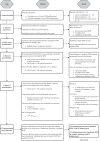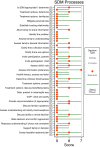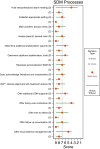Pediatric Shared Decision-Making for Simple and Complex Decisions: Findings From a Delphi Panel
- PMID: 36217896
- PMCID: PMC9647592
- DOI: 10.1542/peds.2022-057978
Pediatric Shared Decision-Making for Simple and Complex Decisions: Findings From a Delphi Panel
Abstract
Objective: To develop recommendations for pediatric shared decision-making (SDM).
Methods: We conducted a Delphi method study from 2020 to 2021 with an international panel (n = 21) of clinicians, researchers, and parents with expertise in pediatric SDM. We conducted semistructured interviews to identify the key processes of pediatric SDM. We coded the interviews using content analysis and developed a questionnaire on the potential processes of pediatric SDM. Using a Likert scale, panelists evaluated each process twice, once for simple decisions and once for complex decisions. Panelists were provided with a summary of the results and evaluated each process again. The processes that were agreed on for simple and complex decisions were reported as "fundamental processes." The processes that were agreed on for complex decisions were reported as "additional processes."
Results: A total of 79 recommendations were developed, including 29 fundamental processes and 14 additional processes for complex decisions. A recurring theme was the importance of personalizing the decision-making process. For example, the panel recommended that physicians should assess the family and child's desired roles in the decision-making process, assess their desired level of directiveness, and elicit and clarify their values, preferences, and goals. The panel also disagreed on several subprocesses, such as how to determine the child's role and the appropriate level of directiveness.
Conclusions: An international expert panel developed recommendations for pediatric SDM for both simple and complex decisions. The recommendations highlight the importance of personalizing the decision-making process.
Copyright © 2022 by the American Academy of Pediatrics.
Conflict of interest statement
Figures
References
-
- Gooding JS, Cooper LG, Blaine AI, Franck LS, Howse JL, Berns SD. Family support and family-centered care in the neonatal intensive care unit: origins, advances, impact. Semin Perinatol. 2011;35(1):20–28 - PubMed
-
- Katz AL, Webb SA; Committee on Bioethics . Informed consent in decision-making in pediatric practice. Pediatrics. 2016;138(2): e20161485. - PubMed
-
- National Quality Forum . NQP shared decision making action brief. In: Proceedings from the National Quality Forum; October, 2017; Washington, DC
-
- World Health Organization . Patient Engagement: Technical Series on Safer Primary Care. Geneva, Switzerland: World Health Organization; 2016
-
- Michaud PA, Jucker-Kupper P, the Profiles Working Group . PROFILES: Principle Relevant Objectives and Framework for Integrated Learning and Education in Switzerland. Bern, Switzerland: Joint Commission of the Swiss Medical Schools; 2017
Publication types
MeSH terms
Grants and funding
LinkOut - more resources
Full Text Sources




